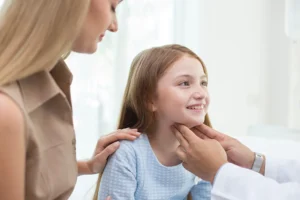Table of Contents

As guardians of our children’s health, understanding the intricacies of their bodily systems can be both enlightening and reassuring. Lymph nodes, often overlooked but crucial components of the immune system, are no exception. As a pediatrician and obesity medicine specialist, I am Dr. Michael Nwaneri, and I present this guide to demystify the role, function, and importance of lymph nodes in maintaining your child’s health.
Laying the Foundation: What Are Lymph Nodes?
Lymph nodes are small, bean-shaped structures that are part of the lymphatic system. They serve as checkpoints and filters for lymph, a clear or slightly yellowish fluid containing white blood cells, which circulates throughout the lymphatic system. The nodes help to trap bacteria, viruses, and other harmful particles, enabling specialized cells to neutralize them.
The Astonishing Anatomy: Where Are They Located?
Lymph nodes are scattered throughout the body but are mainly concentrated in clusters in the following regions:
- Neck (Cervical)
- Armpits (Axillary)
- Groin (Inguinal)
- Chest
- Abdomen
Amazing Functions: The Unsung Heroes of the Immune System
- Filtering Lymph: Trapping and destroying harmful microorganisms.
- Antibody Production: Creating antibodies to fight infections.
- Waste Removal: Filtering out cellular debris and waste products.
Recognizing the Warning Signs: When Should You Be Concerned?
- Swelling: Enlarged lymph nodes can indicate infection or other medical conditions.
- Pain or Tenderness: While usually a sign of infection, it can also signal other issues.
- Fever and Fatigue: Accompanying symptoms that may indicate a systemic issue.
Diagnosing the Enigma: What Tests are Involved?
- Physical Examination: Initial check to assess size and sensitivity.
- Blood Tests: To identify infections or other underlying conditions.
- Imaging Tests: Ultrasound or MRI for further assessment.
- Biopsy: In rare cases, to rule out malignancy.
Treatment Pathways: How Are Issues Managed?
- Wait and Watch: For minor infections, nodes usually return to normal size on their own.
- Antibiotics: Prescribed for bacterial infections.
- Anti-Inflammatory Drugs: To reduce swelling and pain.
- Specialized Treatment: For underlying conditions like cancer or autoimmune diseases.

The Triumph of Preventive Measures: Guarding Your Child’s Health
- Hygiene: Regular handwashing and use of sanitizers.
- Vaccination: Up-to-date immunizations.
- Regular Check-ups: Early identification of any swollen nodes.
Conclusion: Your Ally in the Battle for Good Health
Understanding lymph nodes is an essential step in promoting your child’s optimal health. While they may be small and unassuming, their vital role in the immune system makes them deserving of our attention and understanding.
References
- American Academy of Pediatrics – Lymphatic System
- National Institutes of Health (NIH) – Lymph Nodes
- Mayo Clinic – Lymph Nodes
Disclaimer: This guide is meant for educational purposes and should not replace professional medical advice.
FAQ
What Are Lymph Nodes?
Lymph nodes are small, bean-shaped structures part of the lymphatic system, serving as checkpoints and filters for lymph, a fluid containing white blood cells. They trap and neutralize harmful particles like bacteria and viruses.
Where Are Lymph Nodes Located?
Lymph nodes are concentrated in clusters in regions such as the neck (cervical), armpits (axillary), groin (inguinal), chest, and abdomen, scattered throughout the body.
What Functions Do Lymph Nodes Serve?
Lymph nodes filter lymph, produce antibodies to fight infections, and remove cellular debris and waste products, acting as unsung heroes of the immune system.
When Should You Be Concerned About Lymph Nodes?
Swelling, pain or tenderness, fever, and fatigue are warning signs that may indicate infection or other medical conditions warranting attention.
How Are Lymph Node Issues Managed?
Management includes observation for minor infections, antibiotics for bacterial infections, anti-inflammatory drugs for swelling and pain, and specialized treatment for underlying conditions like cancer or autoimmune diseases.


